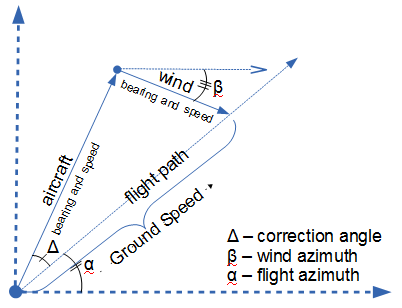Ground Speed
Tags | |
UUID | 7e82b294-ccb9-11e3-b7aa-bc764e2038f2 |
The Aircraft Ground Speed calculator computes the ground speed based on the wind speed (WS), wind direction (β), a Flight Heading (α) and an Air Speed (AS).
INSTRUCTIONS: Choose units and enter the following:
- (α) Flight Direction
- (AS) Air Speed
- (β) Wind Direction
- (WS) Wind Speed
Ground Speed (GS): The calculator returns the ground speed in miles per hour, and the correction angle (Δ) in degrees. However, these can be automatically converted to compatible units (e.g. kilometers per hour) via the pull-down menu.
Flight and Navigation Calculators
- Correction Angle: Computes the navigation angle/azimuth correction angle using the wind speed, wind direction, flight heading and an Air Speed.
- Ground Speed: Computes the ground speed based on the wind speed, wind direction, a Flight Heading and an Air Speed.
- Haversine - Distance: Computes the distance between two points on a spherical model of the Earth along a great circle arc. This also includes the rhumb line distance and azimuth for the rhumb line.
- Travel Time between Coordinates: Computes the time to travel between to points on the globe in a great circle arc at an average velocity.
- Distance to Sea Level Horizon at Altitude: Computes the distance to the horizon from a specified height using a spherical model the mean spherical radius of the Earth
- Force of Drag: Calculates the resisting force of drag on an object flowing through a medium (e.g. air).
- Force of Lift: Computes the lifting force on the surface area of a wing based on the wing surface area, air flow velocity, density of air and a lift coefficient.
- Lift Coefficient: Compute the lift coefficient of a wing based on lift force, wing surface area, wind speed and density of air.
- Velocity Needed for Takeoff: Computes the velocity required to create more lift than the weight of an aircraft or watercraft using a wing (e.g. hydrofoil).
- Glide Ratio: Computes the glide ratio based on the change in forward distance and the change in altitude.
- Wing Surface Area: Computes the wing surface area required to achieve lift, base on a lift coefficient, lift force, wind speed and density of air.
- Velocity of Air over the Wing: Computes the velocity required to achieve a lift, based on lift coefficient, lift force, wing surface area and density of air.
- Air Speed from Pressures: It uses the Bernoulli Equation to estimate air speed based on the total Pressure measured by a pilot tube, total Static local atmospheric pressure and the Density of Air.
- Center of Mass: Computes the vehicle center of mass between two loads (masses).
The Math / Science
The Aircraft Ground Speed is computed using vector arithmetic.
This equation, Ground Speed, references 1 page
Equations and Data Items
This equation, Ground Speed, is used in 3 pages
Calculators
Collections
- Comments
- Attachments
- Stats
No comments |
This site uses cookies to give you the best, most relevant experience. By continuing to browse the site you are agreeing to our use of cookies.

